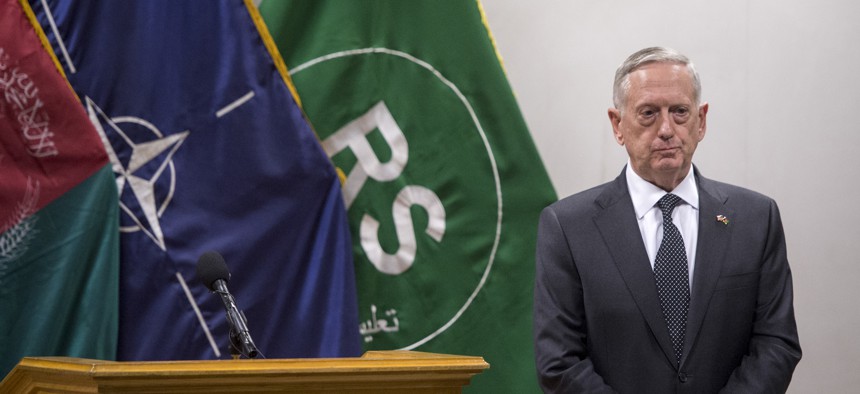
Defense Sec. Jim Mattis on his first visit in office to Resolute Support headquarters in Kabul, Afghanistan, April 24, 2017. DOD photo by U.S. Air Force Tech. Sgt. Brigitte N. Brantley
Mattis’s Afghanistan War Plan: Be Patient, Convince Everyone
Roll back the Taliban. Tackle ISIS. Win over Washington. Build Afghan forces. Seek support from the American public. Sound familiar?
So now it is the Trump administration’s turn at Afghanistan, and to try and wring a winning strategy from the current stalemate as the war nears its 16th year. And then sell that strategy inside and outside of Washington. It is a task that has tested — and largely eluded — the two previous U.S. presidents and their White House war cabinets.
Given the competing voices in Congress and at the White House, in the Pentagon and at the State Department, among Republicans and among Democrats, Trump will need the deal of his life to pull together a cohesive and all-American plan most people – or enough people — can believe in and get behind. After a decade and a half, many in Washington feel confident they have the right plan for Afghanistan. Now it is the Trump team's turn to convince them that theirs is the way to go.
The hunt for consensus in the Afghanistan war is on.
Defense Secretary James Mattis may now possess the power to determine U.S. troop levels for the conflict, but that does not mean he has yet built the buy-in inside the administration to do so.
“Together in the interagency, we will define the way ahead and I will set the U.S. military commitment, consistent with the commander in chief strategic direction and the foreign policy as dictated by Secretary of State Tillerson,” Mattis told lawmakers in the Senate Appropriations Committee, on Wednesday.
The new argument in favor of continuing America’s commitment to its longest war, it turns out, is a lot like the old one. In fact, Mattis said so.
“Our primary national interest and the international interest in Afghanistan is ensuring it does not become an ungoverned space from which attacks can be launched against the United States, other nations or the Afghan people,” he said. “Our overall mission Afghanistan remains the same: to train, advise, and assist the Afghan forces so they can safeguard the Afghan people and terrorists can find no haven in Afghanistan for attacking us or others.”
Yet just because Mattis has the authority doesn't mean he and his team yet have built a plan for how many additional troops will head to Afghanistan — if any. A team at the Pentagon is now working hard to develop a proposal that will win support across the Trump administration, including at the State Department and the National Security Council, headed by Lt. Gen. H.R. McMaster. But Mattis also must win over those inside the administration who, like some in the Obama administration, are wary about increasing America’s troops (and financial) commitment to a war now well into its second decade, described as a “stalemate” by U.S. commanders and a “quagmire” in less-diplomatic military halls.
Related: Defense One's complete coverage of Afghanistan
Related: ISIS-in-Afghanistan Is Losing Recruits to Other Groups, US Officials Say
Related: Three Americans killed in Afghanistan
Sen. John McCain, R-Ariz., chairman of the Senate Armed Services Committee, lectured Mattis and Joint Chiefs Chairman Gen. Joseph Dunford for coming to the Hill with hat in hand, but no strategy – a complaint he frequently made of Obama’s teams.
“We're now six months into this administration, we still haven't got a strategy for Afghanistan. It makes it hard for us to support you when we don't have a strategy. We know what the strategy was for the last eight years, don't lose. That hasn't worked,” he said in Tuesday’s committee hearing with the Pentagon leaders.
Mattis and his team have pushed back on the idea that Afghanistan is a quagmire and have instead urged lawmakers to see that change is coming in “weeks, not months” when a new Afghanistan plan is delivered. They have argued that that change will bring with it an expanded discussion of America’s approach to Afghanistan, and a more robust expression of the extent and durability of that commitment.
“I understand the urgency. I understand it's my responsibility,” Mattis said to McCain, after the senator discussed his own “palpable” frustration at the lack of a war plan from the new administration. “We are not winning in Afghanistan right now. And we will correct this as soon as possible.”
Mattis spoke for many in and out of uniform who served in this administration and the last when he described the current moment. And pleaded for patience in assembling ideas and strategies.
Indeed, what’s hardly been discussed publicly is that U.S. counterterrorism forces in Afghanistan have killed a dozen key leaders of terrorist organizations, thanks to a loosening of the reins granted by President Obama in early 2016. A senior U.S. military official said in April that rule change has helped disrupt several networks that had regained territory and influence in Afghanistan. But news of those missions is overshadowed by the devastation of the security breaches still plaguing Afghanistan, including last month’s enormous car bomb in the middle of Kabul which killed 150 people. What’s missing, for Mattis and many others, is a renewed, cohesive, coherent vision for Afghanistan – even a path to peace – beyond just special operations missions.
“We have entered a strategy-free time and we are scrambling to put it together, but anyone who thinks a strategy — an integrated, interagency, whole of government strategy can be done rapidly is probably someone who hasn't dealt with it,” Mattis told the McCain’s committee.
Undoubtedly the new Afghanistan strategy is traveling the same trail of extended internal reviews that faced its predecessors, from Kabul to U.S. Central Command in Tampa, to the Pentagon. It is prolonged by the fact that more members of the Trump administration’s team have been coming online each week, which means more people — and more voices — to fold into the process.
None of this is new for Afghanistan policy in Washington. Many of the same voices are poring over the same set of questions that vexed the Bush and Obama administrations, and the 4-star war commanders they commissioned to oversee it – including Mattis, six years ago at CENTCOM. What is new is the Pentagon’s ability to not have to deal with a White House that some in the Department of Defense under Obama criticized as far too focused on micro-managing details; this time, the Pentagon’s job will be to convince doubters that the war in Afghanistan is worth pursuing, now and for the foreseeable future.
As for what success looks like — and answering the old Gen. David Petraeus question of “tell me how this ends” — Mattis said Congress should expect an “era of frequent skirmishing,” with more time, training, and space created for Afghan forces. It is not quite the “Afghan good enough” of a half-decade ago, but it is a slimmed-down version of what is possible with help from friends.
Mattis described a goal that sounds awfully familiar: train Afghan forces up enough, and keep enough U.S. in country, so that when insurgents and terrorists flare up, he said, “We can take them down and keep this at a level of threat that the local government and the local security forces can handle,” Mattis said Tuesday. “It's going to be an era of frequent skirmishing and it's going to require a change in our approach from the last several years if we're to get it to that position.”
Part of that shift in approach involves more assistance from the air.
“I think we may be able to, by a change in some of our concepts of operations, help them with air support and fire support,” Mattis said. “That'll put the enemy on the back foot. Right now, I believe that the enemy is surging.”
So as Mattis and team – now half a year into the job – continue working their plan to save Afghanistan from about 20 terrorist organizations still coming at it and threatening its future, they also must win over the public and the president alike.
“The violence will be reduced significantly, especially in the population centers, where most of the people live,” Mattis argued, describing what “winning" looks like. “The Taliban no longer has the freedom of movement that we're seeing right now, that has been rolled back.”
Roll back the Taliban. Tackle ISIS. Win over Washington. Seek support from the American public. Those are just a few of the tasks facing Secretary Mattis and his (still incomplete) team at the Defense Department as they seek to build a consensus for a war sparked by the 9/11 attacks -- a war less than 1 percent of this nation has fought for 16 years.




